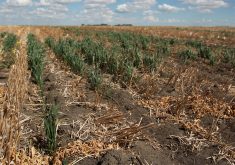SASKATOON – While some farmers battle to kill all traces of burdock found in their crops, Joseph Hashimoto is conjuring up new ways to serve the high fibre root of the plant to his family at the dinner table.
“It tastes very good prepared in tempura batter and served with a dash of soy sauce,” he said.
Burdock root is a popular side dish in Japanese culinary circles and Hashimoto wants to see that trend extend to Saskatchewan.
The retired Porcupine Plain veterinarian is working with University of Saskatchewan horticulturalists to find ways to grow the root for consumption here, as well as learn more about the plant’s medicinal properties.
Read Also

Feedgrain prices expected to plummet
A massive U.S. corn crop is keeping a lid on Canadian feed barley prices.
Because the wild Canadian-grown burdock root is too small to eat, Hashimoto is using seeds from Japan.
The carrot-shaped root grows up to a metre long and can fetch close to $18 per root in a Japanese supermarket, he said.
“It is very popular there,” said Hashimoto, whose father was a professor of horticulture in Japan.
When he first saw the plant growing wild in a farmer’s field near Winnipeg, Hashimoto brought several seeds home to Saskatchewan.
But in his own garden in Porcupine Plain, the plants remained small and the roots would not grow straight.
Export considered
Now, 10 years later, he’s working with university staff to see if burdock root can be grown and pro-cessed in Saskatchewan and sold to the Orient.
“It has been growing very well,” he said, adding the roots are now almost half a metre long. “I think they like it here.”
Branka Barl, herb researcher with the department of horticulture science at the University of Saskatchewan in Saskatoon, said burdock root is considered a medicinal plant used to remedy liver and kidney conditions, purify the blood and treat some skin conditions.
“Our interest is in assessing Saskatchewan’s herb industry and assisting Dr. Hashimoto’s research into growing and processing burdock root here to potentially access the larger Japanese market,” she said.
A test plot containing almost 100 plants planted in May is expected to be ready for harvest later in October.
















